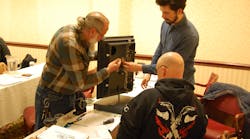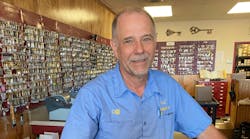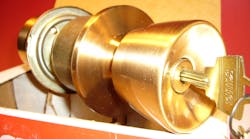The first installment of our Digital Photography for Locksmiths series explained the relationship between shutter speed and aperture. In this installment, I will introduce the useful concepts of Depth of Field and Macro Photography, complete with real-life examples for locksmiths.
Last time we merely fiddled with the dials and buttons to gain familiarity. You will now see that they do indeed have a greater purpose other than “twiddle factor.” I will also touch on a feature called “white balance.” With basic cumulative understanding of these topics, you should have enough knowledge to photograph almost any scene you may encounter.
The turning of the dials and wheels to achieve a decent looking photo may be all well and good for simply getting your point across in the interests of gaining assistance. Anything beyond that, you will be severely disappointed with your efforts.
Histogram
When shooting digital, there is a feature called a histogram. This will be your lifeline to a somewhat properly exposed photograph. Somewhere in your owner's manual will be a section in regards to a histogram. I cannot stress highly enough that you find it, read it, and utilize that feature when shooting.
A histogram is a graph, or chart, of the exposure in your photo. When it is displayed, you will see what appears to be similar to a stock market graph of the year's past history of your favorite company. Dark, or shadows, are represented on the left, and whites, or very light colors toward the right end. There is no right or wrong histogram representation. The “goal” is to have a broad spectrum of light and dark.
If you snap a photo, then view the histogram and it shows the lines bunched toward the left, then you have an underexposed photo. If the lines are jammed toward the right side of the graph, you are overexposed.
With the smallish screens allotted to us for reviewing taken photos, this is the best way to be sure we have a somewhat properly exposed photograph. However, this in no way reveals anything in regards to focus. Properly exposed does not imply nor guarantee properly focused. Use of the histogram is one of the things that will help an inexperienced photographer immensely. It will allow you to “dial in “proper settings much quicker. Once you become more familiar with the camera, your dependency on the histogram will diminish somewhat.
white balance
In the interests of archiving and building your library, we will briefly touch on the subject of white balance. In a nutshell, white balance is the setting used on the camera that tells its computer what temperatures of lighting you are exposing the sensor to. Florescent bulbs give off a whiter, more harsh light than do incandescent bulbs. Incandescent gives off a warmer red-yellow light.
Well, we need to tell the camera that. We need to tell it what “white” really is. Our minds know what “white” is, but the camera does not. A photograph of a white piece of paper under incandescent lighting will appear creamy colored to our eye if we do not make the correction on the camera.
While this may be of no importance to the struggling locksmith who just needs to get out of his predicament, it may be of interest to those of us who would like to document a job well done.
Most of the time, white balance can be left on “auto.” At some point, the camera will be fooled by the ambient light, and you will need to know how and why this is. There are different settings on your camera to make this correction. Everyone's camera is different, so you will have to read your manual to learn the steps necessary to make a correction.
DSLR shooters have an added bonus. There is an easy way to utilize what is called “custom white balance.” This is a feature in which you can photograph a white object under the lighting the photos will be taken. Through menu settings, the camera can learn what “white” is, and this will aid in proper exposure at time of shooting. A coffee filter is a great thing to use for “white.”
Depth of Field
Our next topic is called depth of field. Again, to the tech who is just emailing a picture to someone in the hope of assistance, this may not be extremely critical. It will be to the person documenting a safe lock or taking close-up shots.
Depth of field describes how far into the distance you can see inside the photograph. A very simplistic description, but that is what you need to remember.
Depth of field is very important if you need to see a whole situation in its entirety. It is also important because it is a tool to be used which can make an object distinguish itself.
An example may clear the mud here. Let's say we have finished installing a dozen leversets and deadbolts on a small roadside motel. We did an outstanding job making sure the bolts are all perfectly installed at the same height from the leversets. All 12 of these rooms are in a row, straight on down the line.
We take our camera down to room number one, bend down to lever/bolt height, and take a picture aiming straight down the line to room number 12. Now, we are perfectly oriented so that we can just see the name of the manufacturer on the front of the deadbolt, but we can also see the entire side of the collar. We are 24 inches away from the closed door when we take the picture.
If we set our camera to achieve the narrowest or shallowest DOF, we will see the bolt/leverset on door number one perfectly crisp and sharp in detail. However, door number 2 will be fuzzy and out of focus, door number 3 a little more so, and so on down the line. By the time we reach door number 5, you may not even see the difference between the bolt and leverset it is so out of focus.
Now, if we were to change our settings to achieve a deep DOF, we will be able to see the entire row of our excellent work, in fine detail. So why not just make everything have a deep DOF?
Well, sometimes you don't have a choice depending on the light available. In order to achieve that really deep DOF, you must “stop down” the lens. In other words, you must make the aperture (Av) smaller. The smaller the aperture, the greater the DOF. The larger the aperture (lower number), the shallower the DOF.
Remember how you had played with the Tv and Av to achieve a decently exposed photo? Well, there's the rub. If you stop the lens down to say, f18 so you can have that great depth, you must now compensate with a very slow shutter speed so enough light can get in to the sensor.
I guarantee that if you stop down to f18, you will not be hand-holding your camera with any favorable result. Remember the key machine scenario? The shutter speed will be far too slow. You can't just run the ISO up either. Remember the grain/noise issue? The only way to achieve this shot, is with a tripod and timer. DSLR folks have a few more options, but the tripod stays the same.
These are the limitations of the tool. You can't change the science behind it, it is what it is. By knowing what the limitations of your camera are, you are better able to judge what kind of photo you can manage out in the field.
DSLR users have an advantage here over the P&S. There are certain lenses available to you that will deliver a beautifully distorted background called bokeh. Shoot that prime 100mm lens wide open and that lever/bolt on door number one will jump right off the paper when printed. In other words, it is very pleasing to the eye. DSLR users also have a little more room to play with settings when encountering situations like this.
Macro Photography
The last topic is macro photography, in other words, close up shots. This form of photography is represented on your camera's dial/wheel in the form of a flower. Setting the camera to macro will change the settings to promote that type of photo.
Most folks don't even know the macro function is there. They just stand there in bewilderment and wonder why the “camera” won't take a good picture. If you can reach out and touch it, it is macro mode capable.
“Why do I need a macro shot anyway?” This will probably be the most common photo you will be taking. You must use a macro to see anything at all of scratches, dents, dings, witness marks, pry marks on dead latches, etc...
For example, you need to prove that the wheel post in the customer's 6730 safe lock is worn out, and a lockout is imminent. It needs to be replaced with a new lock. The customer flatly refuses due to price. “Slap some grease in there and put it back together.”
Many of us would now walk away, but for those who don't, a well lit, in focus macro shot of that post will be worth more than its weight in gold when you go to court.
Keep in mind that when shooting in macro mode, you will need to be rock solid. Because you are so close, any movement at all will result in some degree of blurriness. Good lighting is also essential. Here again, the DSLR folks have the upper hand due to lens availability.
Essential Equipment
In today's world, you cannot afford to be without a digital camera. What I have done is to allow myself to carry all of my essentials with one trip from the service truck. With the exception of my automotive scan tool, everything goes with me at the end of the day. Carrying a digital camera is no extra effort on my part. For general day to day work, a point and shoot camera is fine. When I know I will definitely need to shoot that day, I will pack a DSLR, tripod, and the appropriate lenses.
Hopefully this article will afford you a brief insight into still photography. In many cases I provided general examples of camera function and the uses for them. They may not necessarily be “proper,” but they are designed to allow you to think what is happening.
It is my intention for you to get out there and see for yourself how your camera functions, and why it does the things it does. Many resources are available, ranging from books to web site forums to digital photography classes.
Part 1 of Tony Fiorini's Digital Photography for Locksmiths series appeared in the July 2007 issue of Locksmith Ledger, pages 126-132. It is also available online at www.lledger.com.





